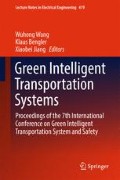Abstract
With the development of urban transportation, more and more working vehicles appear on the road network for maintenance, cleaning, dust suppression etc. However, working vehicle would produce the negative effects to the regional road network when providing a safety and comfortable environment to drivers. Therefore, this paper would conduct the research about the influence of working vehicle on region road network by using microscopic simulation. An influence analysis model based on microscopic simulation will be introduced which contains Paramics Modeler Module and Data Analysis Module. This study focus on the research that how the different working strategy of working vehicle (travel speed, travel lane and working start-time) give an effect on the whole delay of vehicles on the region road network and road safety under the given operation path through importing the control plug-ins of working strategy, which developed with the Application Program Interface (API) in Paramics. The research shows that the influence caused by working vehicle is related to the traffic volume on region road network during the working time. Moreover, the influence on the aspects of the whole delay and links’ safety is different when working vehicle implements the task with different working strategy. Higher speed on the first lane or lower speed on the second lane would produce a big influence on region road network, which is especially obvious in early peak or latter peak. The paper would illustrate the mechanism of the action between working strategy and the influence caused by the working vehicle. Besides, the result of this research will help to formulate a better working plan in reducing the negative effects of working vehicle on road network.
Access this chapter
Tax calculation will be finalised at checkout
Purchases are for personal use only
References
Zheng, Hong, Eric Nava, and Yi-Chang Chiu. 2014. Measuring network wide traffic delay in schedule optimization for work-zone planning in urban networks. IEEE Transactions on Intelligent Transportation Systems 15, no. 6, 2595–2604.
Qu, Tao, et al. 2015. Travel time reliability based highway work zone scheduling. Transportation Research Board 94th Annual Meeting. No. 15-3933.
Schroeder, Bastian J., et al. 2014. Work Zone Traffic Analysis & Impact Assessment. No. FHWA/NC/2012-36.
Kim, Taehyung, Taehyeong Kim, and Hyoungsoo Kim. 2013. A decision-making framework to evaluate traffic control strategies on freeway work zone. International Journal of Control and Automation 6, no. 2: 45–52.
Morgado, João, and Jose Neves. 2014. Work zone planning in pavement rehabilitation: Integrating cost, duration, and user effects. Journal of Construction Engineering and Management 140, no. 11: 04014050.
Amato, F., and X. Querol. 2010. A review on the effectiveness of street sweeping, washing and dust suppressants as urban PM control methods. Science of the Total Environment 408: 3070–3084.
Chang, Yu-Min, et al. 2005. Effectiveness of street sweeping and washing for controlling ambient TSP. Atmospheric Environment 39, no. 10: 1891–1902.
Yu, Yang, Gang Liu, and Jian Wang. 2009. Optimization of snow emergency vehicle scheduling under real-time information. Science Technology and Engineering 19: 024.
Wang, Li Wen, et al. 2011. Optimal scheduling and simulation of snow removers for airfield pavement based on breadth-first search. Advanced Materials Research 214.
Zmuda-Trzebiatowski, Paweł. 2010. Selected aspects of road cleansing in the city of Poznan. LogForum 6, no. 3, 8.
Qu, Xiaobo, Yan Kuang, Erwin Oh. 2014. Safety evaluation for expressways: A comparative study for maroscopic and microscopic indicators. Traffic Injury Prevention 15: 89–93. (Taylor & Francis).
Garber, Nicholas J., and Ravi Gadirau. 1988. Speed variance and its influence on accidents. Reports—Research/Technical (143).
Jenelius, Erik, and Haris N. Koutsopoulos. 2013. Travel time estimation for urban road networks using low frequency probe vehicle data. Transportation Research Part B 53: 64–81.
Yang, Choong Heon, and Amelia C. Regan. 2013. A multi-criteria decision support methodology for implementing truck operation strategies. Transportation 40: 713–728.
Acknowledgements
This study is financially supported by Chinese National Natural Science Foundation (Grant No. 71210001).
Author information
Authors and Affiliations
Corresponding author
Editor information
Editors and Affiliations
Rights and permissions
Copyright information
© 2018 Springer Science+Business Media Singapore
About this paper
Cite this paper
Shang, J., Yan, X., Weng, J. (2018). Influence of Working Vehicles on Traffic Operation in Regional Road Networks Based on Microscopic Traffic Simulation. In: Wang, W., Bengler, K., Jiang, X. (eds) Green Intelligent Transportation Systems. GITSS 2016. Lecture Notes in Electrical Engineering, vol 419. Springer, Singapore. https://doi.org/10.1007/978-981-10-3551-7_11
Download citation
DOI: https://doi.org/10.1007/978-981-10-3551-7_11
Published:
Publisher Name: Springer, Singapore
Print ISBN: 978-981-10-3550-0
Online ISBN: 978-981-10-3551-7
eBook Packages: EngineeringEngineering (R0)

